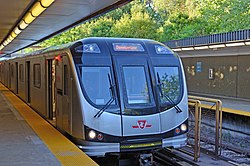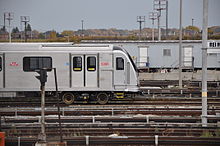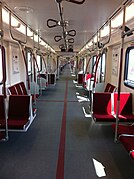
The Toronto Transit Commission (TTC) is the public transport agency that operates bus, subway, streetcar, and paratransit services in Toronto, Ontario, Canada, some of which run into the Peel Region and York Region. It is the oldest and largest of the urban transit service providers in the Greater Toronto Area, with numerous connections to systems serving its surrounding municipalities.

GO Transit is a regional public transit system serving the Greater Golden Horseshoe region of Ontario, Canada. With its hub at Union Station in Toronto, GO Transit's green-and-white trains and buses serve a population of more than seven million across an area over 11,000 square kilometres (4,200 sq mi) stretching from Kitchener in the west to Peterborough in the east, and from Barrie in the north to Niagara Falls in the south. In 2023, the system had a ridership of 56,036,900. GO Transit operates diesel-powered double-decker trains and coach buses, on routes that connect with all local and some long-distance inter-city transit services in its service area.

Innovia Metro is an automated rapid transit system manufactured by Alstom. Innovia Metro systems run on conventional metal rails and pull power from a third rail but are powered by a linear induction motor that provides traction by using magnetic force to pull on a "fourth rail" placed between the running rails. However, newer versions of the technology are available with standard electric rotary propulsion.

Line 4 Sheppard is the newest and shortest subway line of the Toronto subway system, operated by the Toronto Transit Commission (TTC). It opened on November 22, 2002, and has five stations along 5.5 kilometres (3.4 mi) of track, which is built without any open sections in the district of North York along Sheppard Avenue East between Yonge Street and Don Mills Road. All stations are wheelchair accessible and are decorated with unique public art.

The Toronto subway is a rapid transit system serving Toronto and the neighbouring city of Vaughan in Ontario, Canada, operated by the Toronto Transit Commission (TTC). As of September 2023, the subway system is a rail network consisting of three heavy-capacity rail lines operating predominantly underground. As of December 2022, three new lines are under construction: two light rail lines and one light metro line.

Line 2 Bloor–Danforth is a subway line in the Toronto subway system, operated by the Toronto Transit Commission (TTC). It has 31 stations and is 26.2 kilometres (16.3 mi) in length. It opened on February 26, 1966, and extensions at both ends were completed in 1968 and again in 1980.

Line 1 Yonge–University is a rapid transit line on the Toronto subway. It serves Toronto and the neighbouring city of Vaughan in Ontario, Canada. It is operated by the Toronto Transit Commission, has 38 stations and is 38.4 km (23.9 mi) in length, making it the longest line on the subway system. It opened as the "Yonge subway" in 1954 as Canada's first underground passenger rail line, and was extended multiple times between 1963 and 2017. Averaging over 670,000 riders per weekday, Line 1 is the busiest rapid transit line in Canada, and one of the busiest lines in North America.
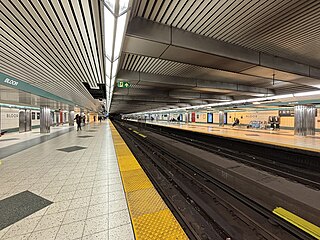
Bloor–Yonge is a subway station on Line 1 Yonge–University and Line 2 Bloor–Danforth in Toronto, Ontario, Canada. Located in Downtown Toronto, under the intersection of Yonge Street and Bloor Street, it is the busiest subway station in the system, handling over 200,000 passengers on an average weekday. Wi-Fi is available at this station.

The Davisville Subway Yard is a rail yard on the Toronto Transit Commission's Yonge subway line. The train maintenance and storage building is referred to as the Davisville Carhouse.

The Urban Transportation Development Corporation Ltd. (UTDC) was a Crown corporation owned by the Government of Ontario, Canada. It was established in the 1970s as a way to enter what was then expected to be a burgeoning market in advanced light rail mass transit systems. It developed significant expertise in linear propulsion, steerable trucks and driverless system controls which were integrated into a transit system known as the Intermediate Capacity Transit System (ICTS). It was designed to provide service at rider levels between a traditional subway on the upper end and buses and streetcars on the lower, filling a niche aimed at suburbs that were otherwise expensive to service.

The H series was the third series of rapid transit rolling stock used in the subway system of Toronto, Ontario, Canada. They were built in six production sets, named H-1 to H-6, from 1965 to 1990 in Thunder Bay, Ontario, for the Toronto Transit Commission (TTC).

The T series, also known as the T-1, is the fourth series of rapid transit rolling stock used in the subway system of Toronto, Ontario, Canada. They were ordered by the Toronto Transit Commission (TTC) in 1992 and built in one production set between 1995 and 2001 by Bombardier Transportation in Thunder Bay, Ontario, Canada.

York University is a subway station on Line 1 Yonge–University of the Toronto subway. It is located on the main Keele Campus of York University, near Ian Macdonald and York Boulevards in the former city of North York. It opened in 2017, as part of the extension of the subway to Vaughan Metropolitan Centre.

The Alstom Movia is a family of metro train cars designed by Adtranz and later built by Bombardier Transportation and Alstom. The structure and body shell are fully customisable for the needs of each system that orders it. Unlike most traditional metro trains, they usually have full-width gangways between carriages, allowing passengers to walk the entire length of the train. The design was developed by Adtranz, which was acquired by Bombardier in 2001. Since Alstom's acquisition of Bombardier in 2021, Alstom will be responsible for construction and delivery of future Movia metro train cars.
Accessibility for people with disabilities on the Toronto Transit Commission (TTC) system is incomplete but improving. Most of the Toronto subway system was built before wheelchair access was a requirement under the Ontarians with Disabilities Act (ODA). However, all subway stations built since 1996 are equipped with elevators, and elevators have been installed in 44 stations built before 1996. Over 75 percent of Toronto's subway stations are accessible. The original plan was to make all stations accessible by 2025; however, a few stations might not be accessible until 2026.
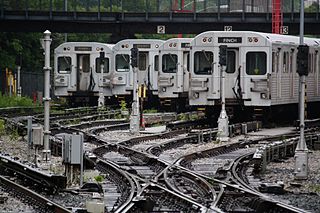
The Toronto subway system's rolling stock consists of 880 subway cars for Line 1 Yonge–University, Line 2 Bloor–Danforth, and Line 4 Sheppard. The rolling stock is owned and maintained by the Toronto Transit Commission (TTC).

The Flexity Outlook is the latest model of streetcar in the rolling stock of the Toronto streetcar system owned by the Toronto Transit Commission (TTC). Based on the Bombardier Flexity, they were first ordered in 2009 and were built by Bombardier Transportation in Thunder Bay and Kingston, Ontario, with specific modifications for Toronto, such as unidirectional operation and the ability to operate on the unique broad Toronto gauge.

A gangway connection is a flexible connector fitted to the end of a railway coach, enabling passengers to move from one coach to another without danger of falling from the train.
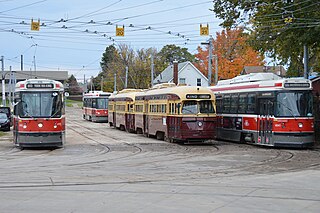
In 1921, the Toronto Transportation Commission (TTC) was created to integrate and operate the Toronto streetcar system. It inherited the infrastructure of two separate streetcar operators: the Toronto Railway Company (TRC) and Toronto Civic Railways (TCR). The TTC immediately embarked on a program to connect the TRC and TCR lines into one network. The TTC had to rebuild most of the track to provide a wider devilstrip so that the wider Peter Witt streetcars it was ordering could pass without sideswiping. Between 1938 and 1945, it placed five orders for air-electric PCC streetcars to replace the old, wooden streetcars of the TRC, and to address rising ridership. Between 1947 and 1951, the TTC placed three orders for all-electric PCC cars, with one order equipped with couplers for multiple-unit operation. Between 1950 and 1957, the TTC purchased PCCs from four American cities. By 1957, the TTC had more PCCs than any other city in North America. After the opening of the Bloor–Danforth subway in 1966, the TTC considered terminating all streetcar service in Toronto. However, in 1972, a citizens group led by Jane Jacobs and Steve Munro called "Streetcars for Toronto" persuaded the City to retain streetcar operation. This led to the development of the Canadian Light Rail Vehicle (CLRV) and its longer, articulated cousin, the Articulated Light Rail Vehicle (ALRV), to replace the aging PCC fleet. The Accessibility for Ontarians with Disabilities Act, 2005 (AODA) mandated that the next generation of streetcars be wheelchair-accessible. Thus, to replace the CLRVs and ALRVs, Bombardier adapted its low-floor Flexity Outlook model for the TTC to navigate the Toronto streetcar system's tight curves and single-point switches, characteristics set in 1921 to accommodate Peter Witt streetcars.
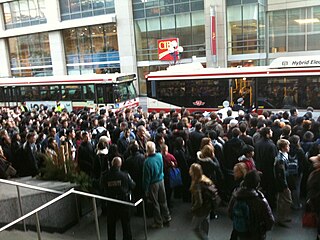
This article lists major incidents of the Toronto Transit Commission (TTC) since 1954, such as accidents and other notable unplanned events.
